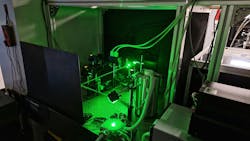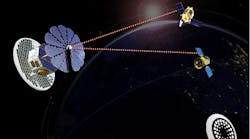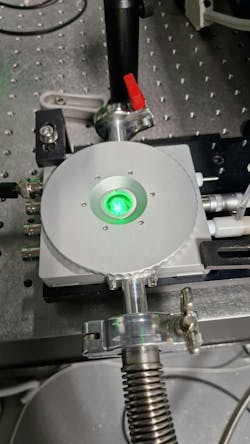Space lasers: What’s up with that?
Laser Focus World: Why use lasers in space?
Stephen Sweeney: There are already many lasers in use in space. Their properties are well suited to space since their coherence allows them to travel long distances. There are so many applications of lasers and it extends into space—as far as Mars. The Mars rovers use lasers to help probe and explore the planet’s surface and materials.
Closer to home, lasers are used for rangefinding objects in space, such as the Moon and artificial satellites in Earth orbit. Lasers are also important for measuring the content of the atmosphere and to help monitor and mitigate the effects of carbon emissions in our atmosphere through remote sensing. Also, optical communications are emerging as a very interesting technology for communications from deep space.
We’re developing laser solutions for beaming energy in space to deliver energy to the ground, day or night, or to help sustain satellites working within low Earth orbit (LEO) where they’re eclipsed by Earth for significant fractions of their time in orbit. Lasers provide an essential extra boost of energy to keep the satellite operational. This has the added benefit of reducing the need to launch more satellites, which reduces space junk.
LFW: Fun fact about lasers in space?
Sweeney: When people think about lasers in space, they probably first think of sci-fi movies like Star Wars, or James Bond villains using space-based lasers. In reality, lasers are mainly used for space applications to benefit people on Earth—to enable better communications, help monitor our environment, or to provide energy more sustainably.
LFW: Are you still working on on-demand laser sources for a wireless power grid in space?
Sweeney: Yes—we’re working with SpacePower (space-power.com) in the U.K. on laser sources for wireless power grids in space and developing approaches for using lasers to operate with existing solar panels on board satellites where we can provide laser illumination in a way that mimics sunlight.
Related Article
One of the key aspects of this work is to develop and understand how well the lasers will operate in space. Much of our current work is focused on exploring how the lasers perform within the vacuum of the space environment and highly variable temperature conditions. To do this, we’re running lab experiments that involve both lasers and solar panels that are in very controlled vacuum and thermal environments where we can vary the temperature from -200° to 200°C. Space can present a harsh radiation environment, so we’re also using lasers as a way of both measuring and potentially compensating for radiation damage to solar panels—and it’s an interesting work in progress.
LFW: What types of lasers/wavelengths are involved?
Sweeney: Many laser types are of interest for space, but for energy applications the focus today is on high-power lasers. We are working with world leaders in high-power semiconductor lasers, the Ferdinand Braun Institut in Berlin, for our experiments. There are several approaches to make high-power lasers—and each has pros and cons for space. We’re now exploring how we can use semiconductor laser arrays to develop sufficient power and where we can control the beam to transmit it long distances.
Wavelengths of interest are largely chosen to maximize the efficiency of transmission, so we need to keep in mind the spectral response of solar panels and choose wavelengths they can absorb efficiently. Unlike the applications for laser transmission on Earth, in space we’re less restricted by issues like atmospheric distortion, eye safety around people, etc., so we can use lasers at shorter wavelengths (where solar panels and lasers can be more efficient).
LFW: How do you target laser light to solar panels?
Sweeney: The idea of using laser light to illuminate solar panels essentially involves matching the output from the lasers to the absorption characteristics of the solar cells. Typically, space-based solar panels use multijunction solar cells to efficiently absorb different parts of the solar spectrum. When we illuminate them with lasers, we use an approach that generates energy within each of these junctions. We’ve developed very innovate ways to do this, such as using a blend of laser wavelengths and intensities tailored to specific solar panel behavior and responsivity while dynamically compensating for their changing thermal environment.
LFW: How big of a problem is space junk?
Sweeney: Space junk is a problem that’s likely to grow, owing to the significant interest in launching and using satellites, such as the recent SpaceX launches to deliver thousands of Starlink satellites for global communications and Internet access. It brings enormous benefits to people on the planet, but we do need to think about the number and location of the ever-increasing objects currently in orbit. This leads to a bigger chance of space junk.
But lasers can help us here as well, because of very interesting technologies being developed that use laser-based ranging systems with retroreflectors on the satellites to be able to monitor and track the positions of satellites in orbit. This makes it simpler to monitor for the presence of space junk and to develop ways to overcome the problem, for example, by moving satellites into slightly different orbits when there’s a risk of collision. LumiSpace (www.lumi.space) in the U.K. is pioneering such technologies.


